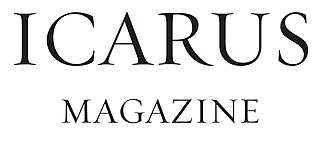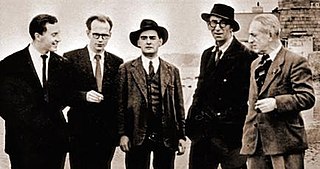
Bloomsday is a commemoration and celebration of the life of Irish writer James Joyce, observed annually in Dublin and elsewhere on 16 June, the day his 1922 novel Ulysses takes place on a Thursday in 1904, the date of his first sexual encounter with his wife-to-be, Nora Barnacle, and named after its protagonist Leopold Bloom.

Irish poetry is poetry written by poets from Ireland, politically the Republic of Ireland and Northern Ireland today. It is mainly written in Irish, though some is in English, Scottish Gaelic and others in Hiberno-Latin. The complex interplay between the two main traditions, and between both of them and other poetries in English and Scottish Gaelic, has produced a body of work that is both rich in variety and difficult to categorise.
Brian Coffey was an Irish poet and publisher. His work was informed by his Catholicism, his background in science and philosophy, and his connection to French surrealism. He was close to an intellectual European Catholic tradition and mainstream Irish Catholic culture. Two of his long poems, Advent (1975) and Death of Hektor (1979), were widely considered to be important works in the canon of Irish poetic modernism. He also ran Advent Books, a small press, during the 1960s and 1970s.
Thomas MacGreevy was a pivotal figure in the history of Irish literary modernism. A poet, he was also director of the National Gallery of Ireland from 1950 to 1963 and served on the first Irish Arts Council.
Blánaid Salkeld was an Irish poet, dramatist, actor, and publisher, whose well-known literary salon was attended by, among others, Patrick Kavanagh and Flann O'Brien.

Brian Merriman or in Irish Brian Mac Giolla Meidhre was an 18th-century Irish language bard, farmer, hedge school teacher, and Irish traditional musician from rural County Clare.

The Egoist was a London literary magazine published from 1914 to 1919, during which time it published important early modernist poetry and fiction. In its manifesto, it claimed to "recognise no taboos", and published a number of controversial works, such as parts of Ulysses. Today, it is considered "England's most important Modernist periodical."
Anthony Gerard Richard Cronin was an Irish poet, arts activist, biographer, commentator, critic, editor and barrister.
The Little Review, was an American avant-garde literary magazine founded by Margaret Anderson in Chicago's historic Fine Arts Building, published literary and art work from 1914 to May 1929. With the help of Jane Heap and Ezra Pound, Anderson created a magazine that featured a wide variety of transatlantic modernists and cultivated many early examples of experimental writing and art. Many contributors were American, British, Irish, and French. In addition to publishing a variety of international literature, The Little Review printed early examples of surrealist artwork and Dadaism. The magazine's most well known work was the serialization of James Joyce's Ulysses.

Modernist literature originated in the late 19th and early 20th centuries, and is characterised by a self-conscious separation from traditional ways of writing in both poetry and prose fiction writing. Modernism experimented with literary form and expression, as exemplified by Ezra Pound's maxim to "Make it new." This literary movement was driven by a conscious desire to overturn traditional modes of representation and express the new sensibilities of the time. The immense human costs of the First World War saw the prevailing assumptions about society reassessed, and much modernist writing engages with the technological advances and societal changes of modernity moving into the 20th century. In Modernist Literature, Mary Ann Gillies notes that these literary themes share the "centrality of a conscious break with the past", one that "emerges as a complex response across continents and disciplines to a changing world".
Declan Kiberd is an Irish writer and scholar with an interest in modern Irish literature, both in the English and Irish languages, which he often approaches through the lens of postcolonial theory. He is also interested in the academic study of children's literature. He serves on the advisory board of the International Review of Irish Culture and is a professor at the University of Notre Dame and at its campus in Dublin. In recent years and with publications such as After Ireland (2018), Kiberd has become a commentator on contemporary Irish social and political issues, particularly as such issues have been examined by Ireland's writers.

The Faber Book of Irish Verse was a poetry anthology edited by John Montague and first published in 1974 by Faber and Faber. Recognised as an important collection, it has been described as 'the only general anthology of Irish verse in the past 30 years that has a claim to be a work of art in itself ... still the freshest introduction to the full range of Irish poetry'. According to Montague, "I'm dealing with a thousand years of Irish verse in under four hundred pages. I needed a thousand pages.'
The Modernist Journals Project (MJP) was created in 1995 at Brown University in order to create a database of digitized periodicals connected with the period loosely associated with modernism. The University of Tulsa joined in 2003. The MJP's website states:
The Modernist Journals Project is a multi-faceted project that aims to be a major resource for the study of modernism and its rise in the English-speaking world, with periodical literature as its central concern. The historical scope of the project has a chronological range of 1890 to 1922, and a geographical range that extends to wherever English language periodicals were published. With magazines at its core, the MJP also offers a range of genres that extends to the digital publication of books directly connected to modernist periodicals and other supporting materials for periodical study.
We end at 1922 for both intellectual and practical reasons. The practical reason is that copyright becomes an issue with publications from 1923 onward. The intellectual reason is that most scholars consider modernism to be fully fledged in 1922, a date marked by the publication of James Joyce's Ulysses, Virginia Woolf’s Jacob’s Room, and T. S. Eliot's The Waste Land. We believe the materials on the MJP website will show how essential magazines were to modernism's rise.

John Jordan was an Irish poet and short-story writer.

Icarus is a student literary magazine based in Trinity College Dublin, publishing work by students, alumni and staff of the university. The magazine is the earliest-founded arts publication still extant in Ireland.
Percival Arland Ussher was an Anglo-Irish academic, essayist and translator.

Envoy, A Review of Literature and Art was a magazine published in Dublin, Ireland, from December 1949 to July 1951. It was founded and edited by John Ryan.

John Ryan (1925–1992) was an Irish artist, broadcaster, publisher, critic, editor, and publican.
Eoin O'Brien LRCP&SI, FRCP, FRCP, is an Irish clinical scientist. He has published extensively on hypertension as one of the major causes of death and disability in society. Alongside his medical career, O'Brien has contributed to the field of literary criticism and biography. He has written books on writers and artists including Samuel Beckett, Nevill Johnson and Con Leventhal.
A.J. Con Leventhal was an Irish lecturer, essayist, and critic.










